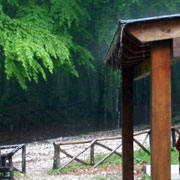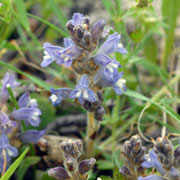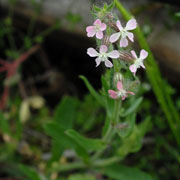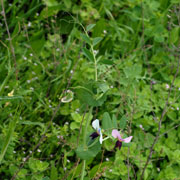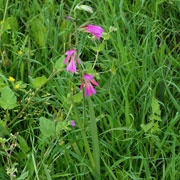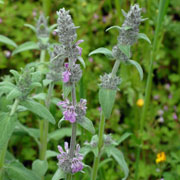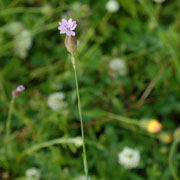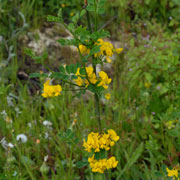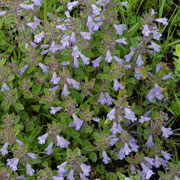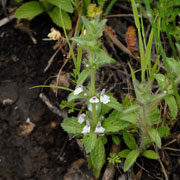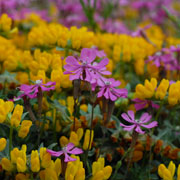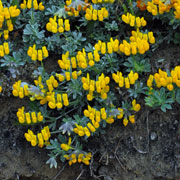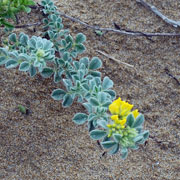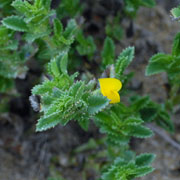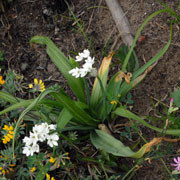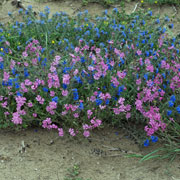Thursday April 23rd 2009
The morning wasn't too bad and cleared up after breakfast leading us to believe that the weather had at last turned. Today though we would travel across the Gargano peninsula, through the forested interior to our second Hotel at Peschici a small town on the coast. The idea was not just to dash to the Hotel but to make a fairly late appearance having stopped at various wild flower sites on the way there.
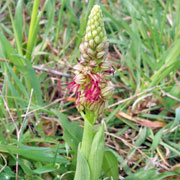
|
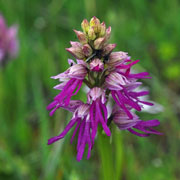
|
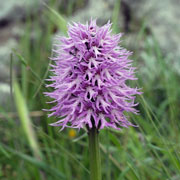
|
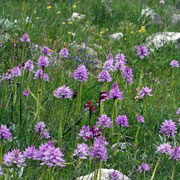
|
| Aceras (Orchis) anthropophorum Man Orchid | Aceras (Orchis) anthropophorum x Orchis italica Hybrid Orchid | Orchis italica Naked Man Orchid | Orchis italica en masse Naked man Orchid group |
Monte St Angelo Meadows Stop 1
Our first stop was quite close to the hotel and we were to look for a rare hybrid which can occur between Orchis italica (Naked man Orchid) and Aceras (Orchis) anthropophorum (Man Orchid). The site was full of Orchis italica with just a few Orchis papilionacea (Pink Butterfly Orchid) and Aceras (Orchis) anthropophorum in amongst the usual meadow flowers such as Alkanna lehmanii. With some difficulty because we had to ascend a steep bank and then get through a barbed wire fence, we gained access to the field and there was this striking hybrid clearly showing the features of both parents.
Waiting by the Cliffs in Monte St Angelo Stop 2
As we got into the minibuses I commented that this was a sad occasion for me because I would certainly never stay at this particular Monte St Angelo Hotel again in my life. After a brief period of reflection and mourning lasting about 4 picoseconds we set out for our first stop. We were to wait while the minibuses parked themselves at either end of a downhill walk called the Pilgrim's Path. While we waited by some cliffs we noted the endemic Aubrieta columnae ssp italica (Aubretia) growing all over the rocks contrasting with Doronicum columnae (Heart-leaved Leopard's-bane) which we had previously seen in the Bosco Quarto forest along with Lamium garganicum and the white Arabis caucasica (Garden Arabis) so often grown in British gardens. Arabis caucasica can be found in huge quantities in the limestone hills of Derbyshire's White Peak. Aubrieta is a tricky genus to spell because often the English name Aubretia appears to be a slight corruption of the systematic name Aubrieta.
The Pilgrims Path Stop 3
By now the clouds had cleared and and the intermittent warm sunshine caused various butterflies to appear. We saw the usual unidentified blues flitting about, an Orange Tip (Anthocharis cardamines), a Swallowtail (Papilio machaon) and two very tatty Large Tortoiseshells (Nymphalis polychloros). Our bird expert was pointing out Blackcaps (Sylvia atricapilla) singing in the hedge, Cetti's warbler (Cettia cetti) some distance away and so on. Many of the plants we had seen before but one was supposed to be yet another variation on Ophrys lutea (Yellow Ophrys) but there's no photo because I'm utterly unconvinced by these very fine splits. I would easily had passed by a buttercup (as would everyone else had our botanical leader not pointed out that this one was Ranunculus garganicus (No English name) a new plant for our Gargano experience. We ambled downhill enjoying a fine morning and waited at the bottom for the minibuses to pick us up. Someone found a huge snail which was identified as an edible Roman Snail (Helix pomatia).
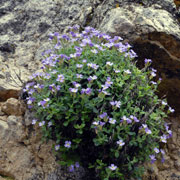
|
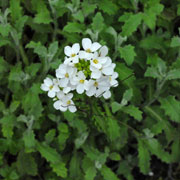
|
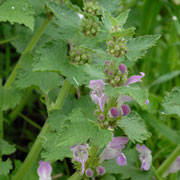
|
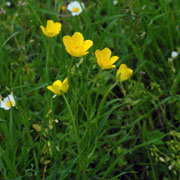
|
| Aubrieta columnae ssp italica Aubretia | Arabis caucasica Garden Arabis | Lamium garganicum Large Red Deadnettle | Ranunculus garganicus No English name |
The Deluge in the Forest Stop 4
We now made our way towards the forest and as one of our party pointed out we seemed to be heading for a rather large black cloud. The sky went dark and it began to rain just spitting at first and then a steady drizzle which turned into proper rain. Thank goodness we thought, this is more like the Italian weather we're used to. By the time we reached the place chosen for a picnic lunch the rain had turned to stair-rods with the incessant drumming on the roof telling us that we weren't likely to be having and outdoor meal on this day. Now the flooding of the site became more apparent and it was a distinct possibility that had we stayed at our off-road site the minibuses would sink into the mire. We drove off searching for some kind of shelter from what was now a real winter deluge. A house was spotted up a track and we thought there might be something there we could use. As we approached it was obvious that this was shut up for the winter and hadn't yet re-opened. There was a house but it had a very useful verandah which we decide to use. There was a bench we dragged in form the wet and dried as best we could. The meal was set out on this damp bench and we ate our lunch (delicious as usual) in the extreme gloom of a house surrounded by tall trees in an extreme downpour.
It couldn't get worse could it? Here we were in southern Italy - southern Italy mind you, skulking in what looked like shepherd's shack sheltering from a storm any resident of the Cairngorms would have thought slightly excessive for the time of year. The trouble is that such conditions prompt calls of nature and I just had to go out in the deluge. Clad in the best anti-storm protection I could muster, I ventured into the forest but just at the crucial moment of relief, a sort of point-of-no-return really, the rain turned to hail. Not only wet but damaged in the nether regions, I returned to be asked whether I'd washed my hands.
Washed my hands? I had an outdoor shower with an arctic sauna. Never in the history of wet picnics have hands been so well washed.
We completed our picnic with water gushing in torrents of the roof of this verandah providing us with a convenient way of doing the washing up. It would be nice to say that during our meal it started to dry up but it didn't and we left the place as we found it and rushed for the minibuses determined to get out of this gloom and wet.
The Fly tip stop: A wet meadow somewhere in the middle of the Gargano Stop 5
Here we stopped for a short time in a lay by which looks as if it is used by the locals to dump rubbish hence Fly tip stop. We were going to look for a very small blue Lupin: Lupinus micranthus (Hairy Lupin) no higher than 10 or 15 cm tall hidden so well in the wet meadow grass that it was difficult not to tread on the plants. It was just coming into flower and in a week or so it would probably be more prominent. What was standing tall was another orchid in the Serapias genus. This time we identified it as Serapias vomeracia (Long-lipped Serapias). In the grass only a few centimetres high was an easily ignored Spurge: Euphobia exigua (Dwarf Spurge) and in the middle of a small pond a very healthy looking Ranunculus muricatus (No English name) which like many members of the Ranunculus genus loves damp or wet places.
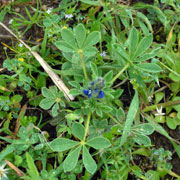
|
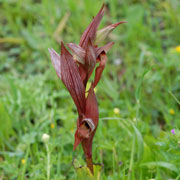
|
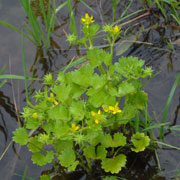
|
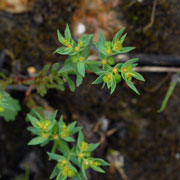
|
| Lupinus micranthus Hairy Lupin | Serapias vomeracea Long-lipped Serapias | Ranunculus muricatus Non English name | Euphorbia exigua Dwarf Spurge |
Stony Corner near Peschici Stop 6
Near our destination it had become drier and we continued to a new site which was known only from hearsay but which turned out to have many interesting plants. The first was an Orchid and a rare one at that. Ophrys bremifera (No English name) has the familiar large labellum of a typical Ophrys but with two unsymmetrical tufts of hair at the side like hairy ears. I thought the lack of symmetry must be a peculiarity of this particular plant but photographs on the internet from other places in the Mediterranean show the same. It could have been confused with Ophrys cornuta (No English name) but the side tufts are much longer and more obvious in that species. Ophrys cornuta is also often unsymmetrical. Being a patch of waste ground Convolvulus althaeoides (Mallow-leaved Convolvulus) had colonised several parts of it. This ground hugging plant is very common in the Mediterranean and will typically be seen on roadside verges or gravelly waste ground.
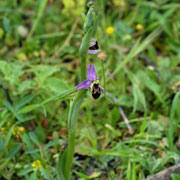
|
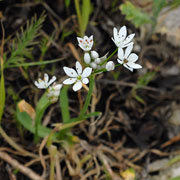
|
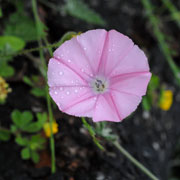
|
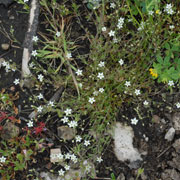
|
| Ophrys bremifera No English name | Allium subhirsutum Hairy Garlic | Convolvulus althaeoides Mallow-leaved Convolvulus | Minuartia sp A Sandwort |
Stony waste land is often excellent for variety of species because the soil is so variable in both texture and acidity. We found several other plants such as Silene gallica (Small-flowered Catchfly), Silene italica (Italian Catchfly), an as yet unidentified Minuartia (A Sandwort) and finally a small blue plant with no chlorophyll which was obviously an Orobanche (A Broomrape).
Orobanche species are parasitic and attach themselves to the roots of their host taking the complex sugars directly without the need to photosynthesise their own. This was small with blue and white flowers which narrowed it down to a few species of which Orobanche ramosa (Branched Broomrape) is the most likely. The obvious characteristic for Branched Broomrape is that it has branches and in some areas of the Mediterranean, it always seems to have them however small the plants. This one though appeared to have no branches which, just to confuse botanists, also happens with this species.
Orobanche ramosa was growing amongst various leguminous plants and that family (Fabiaceae) is one of the hosts it likes to parasitise. The plant it could be confused with Orobanche cernua (No English name) usually parasitise Artemisia species and anyway according to one authority does not occur in this region.
A trip to the Beach Stop 7
By this seventh stop quite a few people wanted just to go to our hotel but there was a possibility of a trip to see seaside plants and this would probably be our only opportunity. We found a place to park the minibuses not far from a track which lead a short way across grassland to the sea. This turned out to be memorable for both birds but most definitely for the combinations of colours we saw in massed plants of the dunes.
On the way to the beach we found Pisum sativum (Wild Pea) which was a beautiful enough plant to grow in a garden and in some long grass by the track Gladiolus italicus (Field Gladiolus) was in flower. In an overgrown corner there were several different plants in flower including Stachys cretica (Mediterranean Woundwort), Petrorhagia velutina (Tunic flower) which is a member of the Pink family, Coronilla emerus ssp emeroides (No English name) and the very hairy Sideritis romana (No English name). I had seen the Sideritis romana in the Mediterranean before and been unable to identify it from my rather poor photographs and so was especially pleased to see and photograph this one. As we found such good species by the track it seemed it could hardly get better but in the small dunes next to the sea we were amazed nay gobsmacked at the colour combinations.
Shocking pink Silene colorata (No English name) grew mixed in with bright yellow Lotus cystoides (No English name) in huge numbers and in another patch the striking deep blue Alkanna lehmanii (Dyer's Alkanet) grew with Silene colorata (No English name). In between these we also found a very hairy Medicago marina (Sea Medick) full of flowers and Ononis variegata (No English name) with scalloped edges to the leaves and single flowers. Also in the dunes there was an Allium with very wide leaves nothing like the A. subhirstum (No English name) and Allium neopolitanum (Neapolitan Garlic) we had seen previously. This turned out to be a new plant Allium trifoliatum (No English name).
During all this time our expert bird enthusiast had worked out that we were standing next to a major route for migrating birds and Hen Harriers were seen passing through. We watched as one even stopped, circled and swooped on something in the marshy ground at the back of the dunes.
Our New Hotel at Peschici
Finally through the back streets of Peschici we arrived at our Hotel to be greeted in the street by the proprietors. Our rooms were good, clean and warm, there was a bar next to a small room with a log fire (so we were in Scotland after all) and after settling in we were led to our long dining table where the attentive waiters supplied us with proper Italian cooking. Perhaps it was the contrast with the other place but to me we ate the finest meal I could remember for while and recalled a contrasting day of weather extremes which had ended so well by the sea.


